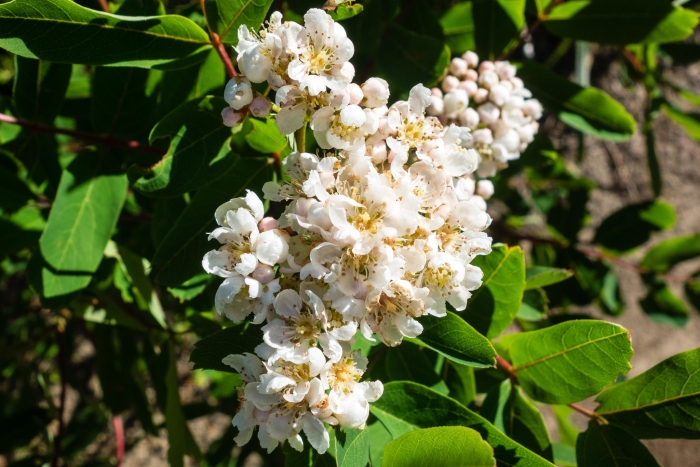Western Mountain Ash
(Sorbus sitchensis)
Western Mountain Ash (Sorbus sitchensis)
/
/

© Dan Harville
CC BY-SA 4.0
Image By:
© Dan Harville
Recorded By:
Copyright:
CC BY-SA 4.0
Copyright Notice:
Photo by: © Dan Harville | License Type: CC BY-SA 4.0 | License URL: http://creativecommons.org/licenses/by-sa/4.0/ | Uploader: danharville | Publisher: iNaturalist |






















Estimated Native Range
Summary
Sorbus sitchensis, commonly known as Western Mountain Ash, is a deciduous shrub or small tree native to the cool temperate rainforests, subalpine zones, and mountainous regions of northwestern North America, from Alaska to northern California. It is often found in moist, well-drained, acidic soils along stream banks, forest clearings, and subalpine meadows. Western Mountain Ash typically grows to a height of 13-33 feet (4-10 meters) with a similar spread, and it features compound leaves that turn yellow to red in the fall.
The plant is noted for its clusters of white flowers that bloom in late spring to early summer, followed by bright red-orange berries that persist into winter, providing a striking contrast against the foliage. These berries are a valuable food source for birds and other wildlife. Western Mountain Ash is used in native plant gardens, as a specimen plant, or in naturalized areas. It requires minimal maintenance once established and is relatively free of serious pests and diseases. It thrives in full sun to part shade and prefers moist conditions, though it can adapt to drier sites once established. There are no popular garden cultivars widely available, but the species itself is appreciated for its natural beauty and ecological value.CC BY-SA 4.0
The plant is noted for its clusters of white flowers that bloom in late spring to early summer, followed by bright red-orange berries that persist into winter, providing a striking contrast against the foliage. These berries are a valuable food source for birds and other wildlife. Western Mountain Ash is used in native plant gardens, as a specimen plant, or in naturalized areas. It requires minimal maintenance once established and is relatively free of serious pests and diseases. It thrives in full sun to part shade and prefers moist conditions, though it can adapt to drier sites once established. There are no popular garden cultivars widely available, but the species itself is appreciated for its natural beauty and ecological value.CC BY-SA 4.0
Plant Description
- Plant Type: Shrub, Tree
- Height: 3.3-20 feet
- Width: 3.3-8 feet
- Growth Rate: Moderate
- Flower Color: Pink, White
- Flowering Season: Spring, Summer
- Leaf Retention: Deciduous
Growth Requirements
- Sun: Full Sun, Part Shade
- Water: Medium
- Drainage: Fast, Medium
Common Uses
Bird Garden, Low Maintenance
Natural Habitat
Cool temperate rainforests, subalpine zones, and mountainous regions along stream banks, forest clearings, and subalpine meadows
Other Names
Common Names: Pacific Mountain Ash, Western Mountain Ash
Scientific Names: , Sorbus sitchensis, Pyrus americana, Pyrus fraxinifolia, Pyrus sambucifolia, Pyrus sitchensis, Pyrus ×splendida, Sorbus americana var. sitchensis, Sorbus americana ×, Sorbus americanus var. sitchensis
GBIF Accepted Name: